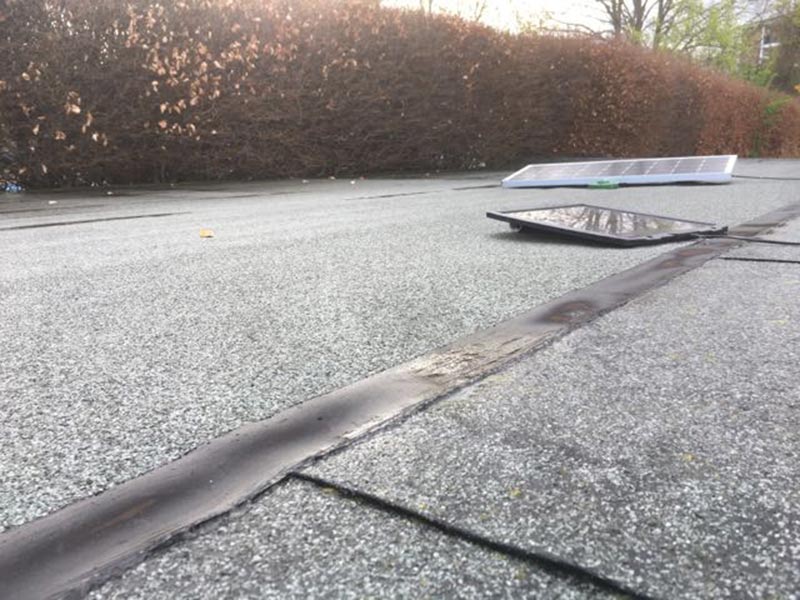What is asbestos roofing felt?
Only a couple of generations ago, asbestos was still a widely used material in the UK, with the construction sector drawing upon it particularly extensively. This naturally occurring mineral was highly regarded due to such qualities as its physical strength, effectiveness as an insulator, and fire resistance. Consequently, asbestos came to be blended into thousands of products, such as asbestos insulating board (AIB), textiles, and cement roof sheeting.
Another once-popular asbestos product, however, was asbestos roofing felt. It is crucial for those with responsibility for managing and maintaining domestic, commercial, and public buildings alike to know exactly what this product is, and the potential dangers around it.
Such knowledge, in turn, will assist a building owner, manager, or anyone else with duties under the current UK asbestos legislation, to make sensible and informed decisions in relation to any asbestos roofing felt still present at their site.
What is asbestos roofing felt and what was it used for?
Asbestos roofing felt is a roofing material that was used in the UK construction industry from around the 1940s until the 1980s (although asbestos was not banned altogether in the UK, in all its forms, until late 1999).
The manufacturing process for asbestos roofing felt – also sometimes referred to as “asbestos felt” or even “asbestos paper” – typically involved asbestos fibres being mixed with a bituminous or resinous binder. Asbestos only usually made up as much as 10% of the overall asbestos roofing felt, although some varieties did consist of 80% asbestos or more.
Asbestos roofing felt was sometimes used as underlay for another roofing product, such as roof slates. On other occasions, however, it was used as a top-layer roofing solution. The product was especially frequently used on outbuildings, such as garages and sheds. It was less commonly used as a damp proof course (DPC) – in other words, as a barrier to prevent damp rising up the walls of a building.
The peak period of manufacture for asbestos roofing felt largely coincided with a time when the health risks of asbestos were not yet widely known, and the fibrous silicate mineral still had a reputation as being a “wonder material”. In the case of roofing felt, asbestos was incorporated in order to boost the product’s fire resistance and durability.
What does asbestos roofing felt look like?
It must always be emphasised that no one should use visual inspection alone as a means of determining whether a particular material does or does not contain asbestos. In order to confirm this for any roofing felt at your property, you will need to arrange for the product to be directly tested or surveyed, with a sample being taken for analysis.
However, it can still be advantageous to know a few things about what asbestos roofing felt tends to look like, particularly given that it is one of the easier asbestos products to visually identify. Asbestos roofing felt is typically black, grey, and white speckled in its appearance, in addition to having a textured surface.
Standard, non-asbestos roofing felt tends to have a slight green tinge that is absent from its asbestos-containing counterpart, although the two types can still be easily confused. So, if you are in any doubt at all – for example, because there isn’t an asbestos report available for any previous asbestos survey carried out on the site – arranging for a new survey to be undertaken will help to ensure you can act on the most up-to-date information.
How can you identify asbestos roofing felt?
When you are visually inspecting roofing felt to attempt to determine whether it contains asbestos, you should bear in mind the exceptions that can apply to the aforementioned advice.
While, for example, asbestos roofing felt can have a slightly rough surface, in some cases it can be smooth, depending on the specific manufacturing processes that were used. This underscores the importance of scrutinising the material closely for any sign of the fibrous or granular texture that is characteristic of asbestos.
Don’t forget to also consult relevant documentation, such as building records, inspection reports, or renovation records. These may mention whether asbestos was used in certain parts of the property’s construction.
Where is asbestos roofing felt commonly found?
As we mentioned above, the use of asbestos roofing felt has historically been particularly strongly associated with sheds, garages, and similar outbuildings. This, combined with the fact that the final ban on asbestos in the UK was not imposed until 1999, means you should be especially vigilant about the material’s possible presence if there are any old, 20th-century outbuildings on your site that might have gone unused for many years.
It is also true, though, that with asbestos roofing felt having been used as underlay to roofing slates and for DPC purposes, it is not only outbuildings where it may be present. So, almost any UK property dating to before the 1999 ban could conceivably have asbestos felt on its roof.
How dangerous is asbestos roofing felt?
The main health and safety concern in relation to asbestos felt roofing, is the possibility that in the event of the material being damaged or deteriorating over time, or even simply being disturbed in some other way (for example, during a property renovation or asbestos removal project), it could release loose asbestos fibres.
If such a release of airborne asbestos fibres was to occur, someone nearby could easily inhale or swallow them. Those fibres could then travel deep into the lungs and become trapped in the lung tissue. This could elevate the likelihood of the exposed individual developing a potentially fatal health condition, such as asbestosis or mesothelioma, many years later.
On the other hand, it is also true that asbestos roofing felt is considered a “lower-risk” asbestos-containing material (ACM) compared to certain other products. This helps to explain the UK Health and Safety Executive (HSE)’s relatively more relaxed stance on asbestos felt from a licensing perspective, as we will explain further below.
One factor in asbestos roofing felt being perceived as “lower risk”, is its relatively low friability compared to some other asbestos products. In other words, when someone disturbs asbestos roofing felt or otherwise directly handles it, the material might not crumble or break apart very easily – a situation that may lower the risk of accidental asbestos fibre release. Still, such friability might increase as the given asbestos roofing felt ages.
Do you need a licence to remove asbestos roofing felt?
If you are looking to carry out work on certain ACMs – such as the removal of asbestos roofing felt – at a property for which you are responsible, you will need to pay close attention to the HSE’s rules on licensing. Most higher-risk work with asbestos must only be undertaken by a licensed contractor, but it is ultimately the specific risk involved that will determine whether any given project is licensable.
In order to be exempt from the need for a licence, asbestos work will need to be sporadic and of low intensity, with the concentration of asbestos in the air not exceeding 0.6 fibres per cubic centimetre of air (f/cm3), measured over 10 minutes. Furthermore, the work must be done in such a way that workers’ exposure to asbestos does not exceed the legal control limit of 0.1 f/cm3, averaged over a period of four hours.
Full information on the conditions that will need to be met for a licence to be unnecessary is outlined on the HSE website. Intriguingly, and in recognition of the comparatively lower risks as described above, the regulator cites maintenance work on asbestos-containing felt – including asbestos-containing bitumen roof felt – as an example of non-licensed work with asbestos. So, you won’t strictly need a licensed contractor in order to remove it.
However, there is a crucial distinction to be made between whether you will legally need to hire an HSE-licensed contractor for a given asbestos removal task, and whether you should do so anyway.
As we have explained in the past, a particular asbestos removal company holding a licence does indicate that the HSE has judged them to be competent and knowledgeable in all forms of asbestos remediation. To put it another way, when you hire an HSE-licensed contractor to remove asbestos roofing felt from your building, you can be confident that they will use effective and safe methods for such an operation.
What should you do if you suspect asbestos roofing felt?
If you see any materials at your property that you suspect to be asbestos roofing felt, we would advise you to take the following steps:
- Avoid any actions that could cause potentially dangerous disturbance to the material. This includes any activities directly on the materials that could lead to airborne asbestos fibres being released, such as drilling, cutting, or scraping.
- Inform occupants of the building about the presence of asbestos roofing felt. You should give them information on the potential health risks of coming into contact with the substance, in addition to advising them to avoid the affected area.
- Contact asbestos professionals, such as surveyors and removal experts. They will be able to assist with such processes as inspecting the condition of the roofing felt, determining whether it contains asbestos, and advising you on the best course of action. They can also help ensure your compliance with all relevant asbestos regulations as you look to manage and/or remove the material from your property.
- Arrange for testing and evaluation by qualified experts. If you are in charge of the maintenance of a given non-domestic property where suspected asbestos roofing felt has been found, arranging a professional asbestos survey will enable you to comply with your obligations under the Control of Asbestos Regulations 2012 (CAR 2012).
- Create, implement, and monitor an asbestos management plan. Having an asbestos survey carried out will enable you to benefit from up-to-date information on the exact asbestos situation at your property. This information can then be fed into the asbestos management plan, which will outline how the asbestos risks on your premises will be managed. This is another legal obligation, in accordance with Regulation 4 of CAR 2012.
Conclusion: be alert to asbestos roofing felt at your property, and how to manage it
Asbestos roofing felt is by no means the most talked-about asbestos-containing product to have been used during the time when asbestos was a legally permitted material in the UK construction sector, and it might not even be the most dangerous.
However, if you own and/or manage a building in the UK that was constructed or renovated prior to the year 2000, you should still ensure you are suitably vigilant and educated about this product. This should include being aware of the potential risks, and the steps that you may need to take to comply with the UK’s present asbestos legislation.
One of the key things to emphasise about asbestos management, is the importance of consulting qualified and experienced professionals – such as those on the Oracle Solutions team – to help ensure you make the right decisions. Please feel free to contact our experts now to learn more about our asbestos services and to receive a fast and free quote.

Written by Mark Carter
Mark Carter is a renowned expert in asbestos management, offering clients vital guidance on compliance and safety. His expertise is invaluable for navigating asbestos regulations, ensuring both safety and legal adherence. Mark's role is central in providing effective asbestos-related solutions, helping clients achieve their business objectives with an emphasis on regulatory compliance and safety in asbestos management.

